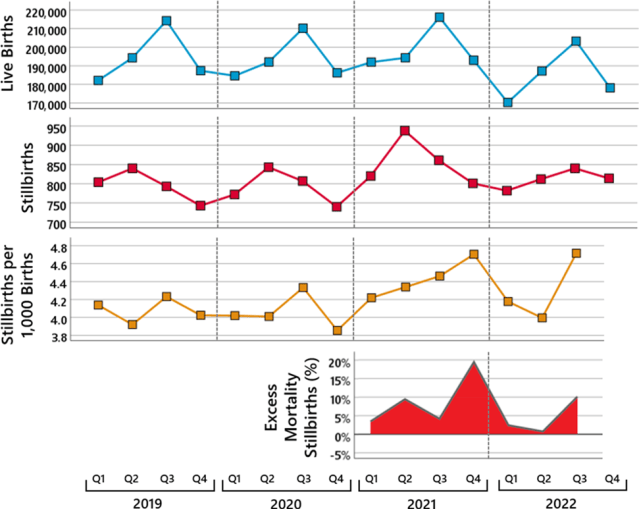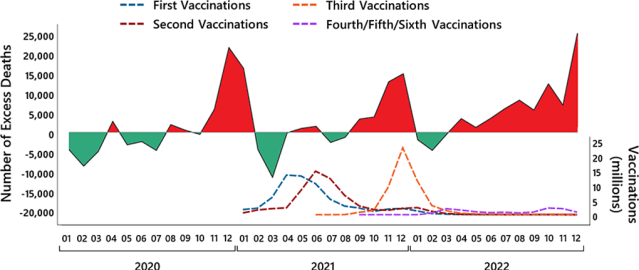A new study finds a sudden and sustained increase in excess deaths and stillbirths in Germany from April 2021
A new study used state-of-the-art actuarial science to examine excess deaths in Germany. The study set out to estimate covid deaths. There were no excess deaths in 2020 but “something must have happened in spring 2021 that led to a sudden and sustained increase in mortality,” the study said. A similar mortality pattern was observed for stillbirths.
The study also explored factors which could explain these mortality patterns one of which was to compare mortality patterns to covid vaccination campaigns. It found that during the months with a high number of vaccinations, there was also a high number of excess deaths.
Given this relationship, the study authors noted: “It seems surprising that a respective safety signal has not been detected in the pharmacovigilance by the Paul-Ehrlich-Institut (PEI).” And so, the study included a brief investigation into PEI’s safety analysis which they found to be flawed.
Let’s not lose touch…Your Government and Big Tech are actively trying to censor the information reported by The Exposé to serve their own needs. Subscribe now to make sure you receive the latest uncensored news in your inbox…
The German Federal Statistical Office fails to account for the effects of changes in the size and age profile of the population in its estimation of excess deaths. And the World Health Organisation also fails to take into account the effects of historical trends in mortality rates. “The estimations provided by the WHO not only ignore long-term trends but also changes in population,” the study authors noted.
To account for these effects, the study used a state-of-the-art method of actuarial science – based on population tables, life tables and longevity trends – to estimate the expected number of all-cause deaths from 2020 to 2022 as if there had been no pandemic. This expected number of all-cause deaths was then compared to the reported number of all-cause deaths to calculate the excess mortality.
“The results show that the observed number of deaths in 2020 was close to the expected number with respect to the empirical standard deviation … By contrast, in 2021, the observed number of deaths was two empirical standard deviations above the expected number and even more than four times the empirical standard deviation in 2022,” the study said.
The empirical rule, also called the “three-sigma rule” or the “68-95-99.7 rule,” is a statistical rule that states that, for normally distributed data, almost all the data points will fall within three standard deviations on either side of the mean (average value) – 68% of data within 1 standard deviation; 95% of data within 2 standard deviations; and 99.7% of data within 3 standard deviations. Higher standard deviation (sigma) values mean that the discovery is less and less likely to be accidentally a mistake, “random chance” or a result of random variations.
In other words, the 2021 three standard deviation (3-sigma) observed is on the outer limits of what is expected but the 2022 four standard deviation (4-sigma) falls outside the normal distribution. If the distribution of a dataset is normal, 4-sigma is rarely seen.
Number of Excess Deaths
The study approximated excess deaths in 2020 to be 4,000. However, the number of excess deaths was 8.5 times that in 2021 and doubled in 2022 to 16.5 times the number of excess deaths in 2020:
In total, the number of excess deaths in the year 2021 is about 34,000 and in 2022 about 66,000 deaths, yielding a cumulated 100,000 excess deaths in both years.
It should be pointed out that in the last 20 years, the maximal excess mortality in a year was about 25,000 deaths, and the authors are not aware of an excess mortality of more than 60,000 deaths – or in two consecutive years about 100,000 deaths – in the last decades.
Kuhbandner C, Reitzner M (May 23, 2023) Estimation of Excess Mortality in Germany During 2020-2022. Cureus 15(5): e39371. doi:10.7759/cureus.39371
Overall, in 2020, the observed number of deaths was an increase of 0.4% extremely close to the expected number … By contrast, in 2021, the number of observed deaths was 3.4% higher than the number of expected deaths … In 2022, the number of observed deaths was even 6.6% higher than the number of expected deaths.
Kuhbandner C, Reitzner M (May 23, 2023) Estimation of Excess Mortality in Germany During 2020-2022. Cureus 15(5): e39371. doi:10.7759/cureus.39371
The study noted that the high excess mortality in 2021 and 2022 was mainly due to an increase in deaths in the age groups between 15 and 79 years and started to accumulate only from April 2021 onward.
Number of Stillbirths
A mortality pattern similar to excess deaths in “living persons” was observed for stillbirths. In 2020 there was no change in the number of stillbirths compared to 2019. In 2021, there was a sudden increase in the second quarter, increasing further in the fourth quarter. In 2022, the stillbirth rate stayed unusually high, reaching a maximum in the third quarter. The study authors noted that “the quarterly pattern observed in the year 2022 must be interpreted with caution because only preliminary data is available based on the reporting month.”
The number of stillbirths per 1,000 total births increased by 9.4% in the second quarter of 2021 and by 19.4% in the fourth quarter of 2021.
Stillbirths precede live births from the same pregnancy cohort by about one trimester. So, at the time of the study, the number of stillbirths per 1,000 total births could not be determined for the fourth quarter of 2022 because the number of live births in the first quarter of 2023 had not yet been published by the Federal Statistical Office of Germany.
Until the end of 2021, the number of live births shows a stable course with a regularly repeating seasonal pattern.
In the first quarter of 2022, a sudden and sustained drop in the number of births is observed.
Regarding the number of stillbirths, a stable course is observed until the end of the first quarter of 2021. In the second quarter of 2021, a sudden increase in stillbirths is observed, despite the stable course of live births until the end of 2021.
Kuhbandner C, Reitzner M (May 23, 2023) Estimation of Excess Mortality in Germany During 2020-2022. Cureus 15(5): e39371. doi:10.7759/cureus.39371

Kuhbandner C, Reitzner M (May 23, 2023) Estimation of Excess Mortality in Germany During 2020-2022. Cureus 15(5): e39371. doi:10.7759/cureus.39371
What Happened in the Spring of 2021?
Because excess deaths in 2020 were as expected but there was a sudden and sustained increase from spring 2021 the study authors explored three factors that may explain the trend: number of covid deaths, covid vaccination campaigns and measures imposed in response to covid.
Regarding the number of deaths as reported by the German Robert Koch Institute, the study authors noted: “It is misleading to measure the risk of the covid-19 pandemic only using the reported covid-19 deaths. One should rather use the excess mortality curve than the number of reported covid-19 deaths, or a combination of both.”
Regarding the covid vaccination campaigns, the study noted: “If the vaccinations successfully prevent people from dying from covid-19, a straightforward prediction is that excess mortality should decrease with an increased number of vaccinated persons … [but] during periods when many persons were vaccinated, excess mortality seems to have increased … both excess mortality and the number of stillbirths increased with increased vaccinations.”
Inspecting the numbers of vaccinations and excess deaths per month confirms … Other than in the year before, during the months with a high number of the first, second, and third vaccinations, also a high number of excess deaths was observed. The temporal relationship between the courses of vaccinations and excess deaths is especially pronounced for the third vaccination.
Kuhbandner C, Reitzner M (May 23, 2023) Estimation of Excess Mortality in Germany During 2020-2022. Cureus 15(5): e39371. doi:10.7759/cureus.39371

Kuhbandner C, Reitzner M (May 23, 2023) Estimation of Excess Mortality in Germany During 2020-2022. Cureus 15(5): e39371. doi:10.7759/cureus.39371
Given the temporal relationship between the increase in vaccinations and excess mortality, it seems surprising that a respective safety signal has not been detected in the pharmacovigilance by the Paul-Ehrlich-Institut (PEI), which is responsible for the safety monitoring of drugs in Germany.
A closer inspection of the methods used by the PEI to monitor possibly deadly side effects of the covid-19 vaccinations reveals that a flawed safety analysis is used that will not indicate a safety signal even if a vaccine causes extremely large numbers of unexpected deaths.
Kuhbandner C, Reitzner M (May 23, 2023) Estimation of Excess Mortality in Germany During 2020-2022. Cureus 15(5): e39371. doi:10.7759/cureus.39371
Featured image: People wearing masks stand in line to get vaccinated in Hamburg, Germany, on 22 Nov. 2021

This article has been archived for your research. The original version from The Exposé can be found here.



